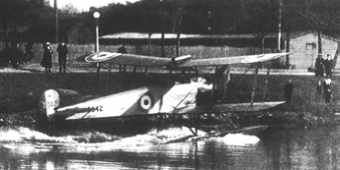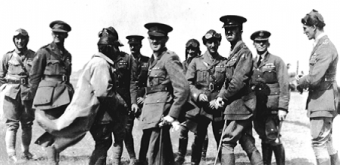On its formation on 31 March 1921, the RAAF was the second independent air force in the world—after the Royal Air Force (RAF). But another distinct “air force” flew aircraft, set records and carried out government tasks in Australia well before this date. How did this force come about and what happened to it?
Even before the end of World War I, there was political debate about the future of military aviation in Australia, which at that stage consisted of little more than the Central Flying School (CFS) at Point Cook, Victoria, for training pilots. By May 1918, both Army and Navy had submitted detailed proposals for permanent air arms — one for each service. When a compromise could not be reached within the allocated budget, a sub-committee that was set up to examine the problem recommended on 20 January 1919 the creation of a separate air force as a third service.
The government accordingly formed the Air Services Committee (ASC) as a temporary body to organise the new air force. The ASC soon produced a plan for new airbases, an organisational structure and an Air Board to administer the service. At this time, Australia had few combat aircraft. In the first months of 1919 the squadrons of the Australian Flying Corps (AFC) abroad began handing their aircraft over to the RAF in preparation for the AFC’s disbandment and return home.
In April, the CFS received a number of Avro 504 and Sopwith Pup aircraft which had been ordered the previous year. The number of aircraft was adequate for a training school, but provided no aircraft to equip proposed new squadrons. Then in June, the British Government offered a gift of military aircraft, the object being ‘to assist Dominions wishing to establish air forces and thereby develop defence of the Empire by air.’ The Australian Government quickly accepted the offer but requested a delay to the dispatch of the aircraft until arrangements could be made for their reception.
The ‘Imperial Gift’ consisted of 100 aircraft, spare engines, tools, motor transport and 13 transportable hangars all packed away in over 19 000 packing cases. Another 28 aircraft were provided at the same time to replace aircraft donated by the people of Australia to Britain during the war. With dozens of new aircraft on their way, the pressure to form the new air service was immense. In its report dated 30 June 1919, the ASC recommended the creation of a temporary ‘Australian Air Corps’ (AAC) formed into two wings (one wing to meet the needs of the Navy and the other for the Army). An Air Board, answering to the Minister for Defence, would administer the new service. According to the Commonwealth Gazette of 31 December 1919, the CFS, its personnel and equipment were seconded from the Army and placed under the AAC.
Major William Anderson, who had extensive service in the AFC, including as Commanding Officer of No 3 Squadron, was selected to command at Point Cook. An establishment of nine officers and 70 other ranks was initially authorised but was soon increased to 160 other ranks to handle the volume of gift stores arriving in Australia. Command arrangements for the new air service were controversial from the start. An Air Council, with Army and Navy representatives, was formed in early 1920 to decide matters of higher policy and to ensure that the new air service did not stray too far from its primary role of meeting the needs of both the Army and Navy. In January 1920, Lieutenant Colonel Richard Williams (later Air Marshal Sir Richard Williams) was appointed Acting Director of Aviation Services, responsible to the Air Council for all matters connected with the AAC.
The interim nature of the new organisation was shown by the order issued by Captain H.H. (‘Neil’) Kilby, the Adjutant of CFS, less than three weeks after its formation:
…it has been approved that no distinct uniform shall be designed — that uniform at present in possession of members may be worn out, and that should members find it necessary to purchase new uniform while the Corps is constituted at present, AIF pattern, as worn by the AFC is to be worn.
Despite this order, over the next 12 months, the AAC gradually assumed an identity of its own. A major step in this direction occurred in November 1920, when the change was made from Army ranks to those adopted by the RAF in August 1919. On 9 November 1920, the Air Board was formally established as the body responsible for the administration of the AAC and the future Air Force. Wing Commanders Richard Williams and Stanley James (‘Jimmy’) Goble (later Air Vice-Marshal Goble) were members of the board alongside Squadron Leader P.A. McBain, Major P.E. Coleman (the civilian Secretary) and a civilian finance member, Mr A.C. Joyce.
Although the AAC was formed primarily to maintain equipment in good order, it achieved some commendable aviation milestones. Its aircraft set a new Australian altitude record of 27 000 feet in June 1920 and made the first non-stop Sydney to Melbourne flight the following month. Between July and November, an Avro 504 floatplane and AAC personnel embarked aboard the battle cruiser HMAS Australia (I) for sea trials. In addition, AAC aircraft flew many aerial displays, and made at least one aerial search for a missing vessel.
Throughout its short existence, the AAC consisted of one flying unit — the CFS — and one airfield — Point Cook. Most of its aircraft were still in storage or in transit from Britain, but it operated a number of training, bomber/reconnaissance and fighter aircraft. It was a uniformed service with a command and rank structure and most importantly, personnel with extensive operational experience from World War I. And it was technically separate from the Army and Navy; its director answered to the Minister for Defence, through the Air Council. In effect, the AAC was Australia’s first independent air force, albeit an interim one.
The senior officers of the AAC went on to influential careers in the RAAF. Apart from Williams and Goble, William Anderson served more than 10 years as a member of the Air Board before retiring in April 1946 with the honorary rank of Air Vice-Marshal. ‘Harry’ Cobby, Frank McNamara, Henry Wrigley and a large number of technical staff also went on to distinguished careers in the RAAF after serving in the AAC. However, not all AAC personnel automatically transferred to the RAAF — some chose to return to civilian careers.
The AAC achieved much in its short existence. It was the physical embodiment of an Australian air service that was broadly independent of Army and Navy. Its most important function was to form the core of the Australian Air Force when it came into existence on 31 March 1921. With the personnel from the AAC and the aircraft and equipment from the Imperial Gift, the RAAF was a viable, independent air force capable of flying missions from the first day of its existence.
Highly trained Air Forces are now essential components of all efficient defensive and
fighting forces, as aviation provides a new and distinct striking force of tremendous potentiality… A Nation thinking in three dimensions will lead and defeat a nation thinking in two, both in time of peace and war.
Report on NZ air defence by Colonel A.V. Bettington, RAF, June 1919


First published in Pathfinder – Air Power Development Centre Bulletin, Issue 145, November 2010
Contact Office of Air Force History about this article.






